Tips for using your headlights effectively

Jan. 17, 2019. Using your headlights seems intuitive but there may be facts you may be unaware of including when they are required to be on. Because reduced visibility increases your chances of being involved in a collision, it’s important to be aware of how to use your headlights effectively.
“Phantom vehicles,” or cars that don’t have their lights on at night, are such a problem that new regulations will come into effect in September 2021. They will require that new vehicles for the Canadian market come either with lights that turn on automatically in low light conditions and daytime running lights and taillights that turn on when the dashboard is illuminated or with dashboards that will not light up until the lights have been turned on by the driver.
When are you legally required to use your headlights?
- In Alberta, you must use your headlights when visibility is 150m or less or at night
- Use low beams when you are driving 150m or less behind another vehicle
- Use your low beams when you are 300m or closer to an oncoming car even on a divided highway
What requirements do your lights have to meet?
- Except for motorcycles and mopeds, there must be at least two headlights on the front of the vehicle
- The emitted light must be white and there can be no modifications that change its color
- Taillights must emit red light that is visible from at least 150m
Tips for driving in low light conditions
- Make sure your headlights are aimed properly so you can see well and don’t blind other drivers
- Keep your lights and windows clean
- Distances are more difficult to judge at night. Be aware of your surroundings and maintain your following distance from other vehicles.
- Use your high beams on poorly lit roads
- Watch the lights on the cars ahead of you to see if there are bumps or obstacles or the traffic ahead is slowing down
- Bad weather affects visibility, so drive with the same level of caution for the road conditions
- Watch for animals, especially at dawn and dusk. Visibility is reduced at these times and animals are more active. Look for movement and the glow of eyes reflecting light back to you
- If you’re getting tired, pull over to walk around, get a coffee, or take a nap so you can be alert
When should you use high beams?
High beams aren’t always effective in low light conditions. If you’re driving in smoke or fog, use your low beams so the light doesn’t reflect and cause glare. This also happens with rain, snow, dust, or smoke.
What if one of your headlights is broken?
If one of your headlights burns out or is broken, fix it as soon as you can and avoid driving at night for safety reasons. Although not a common traffic infraction, you can get a ticket for not having both headlights on at night.



